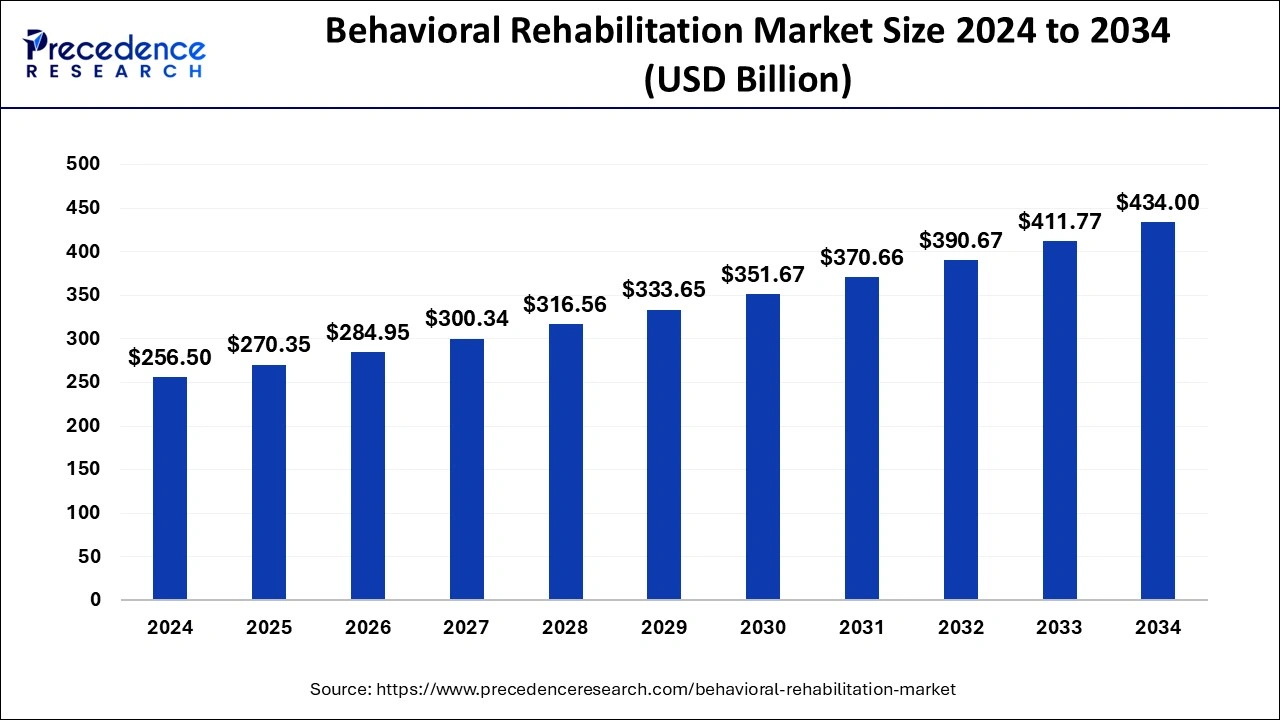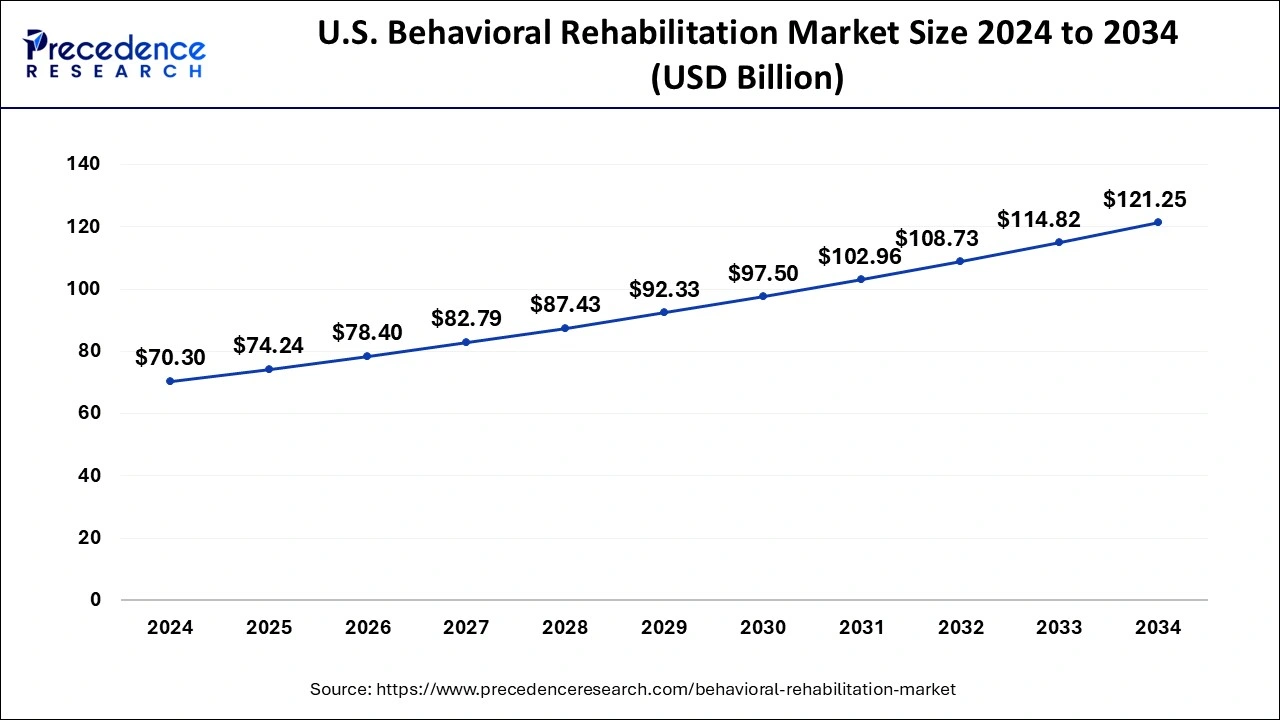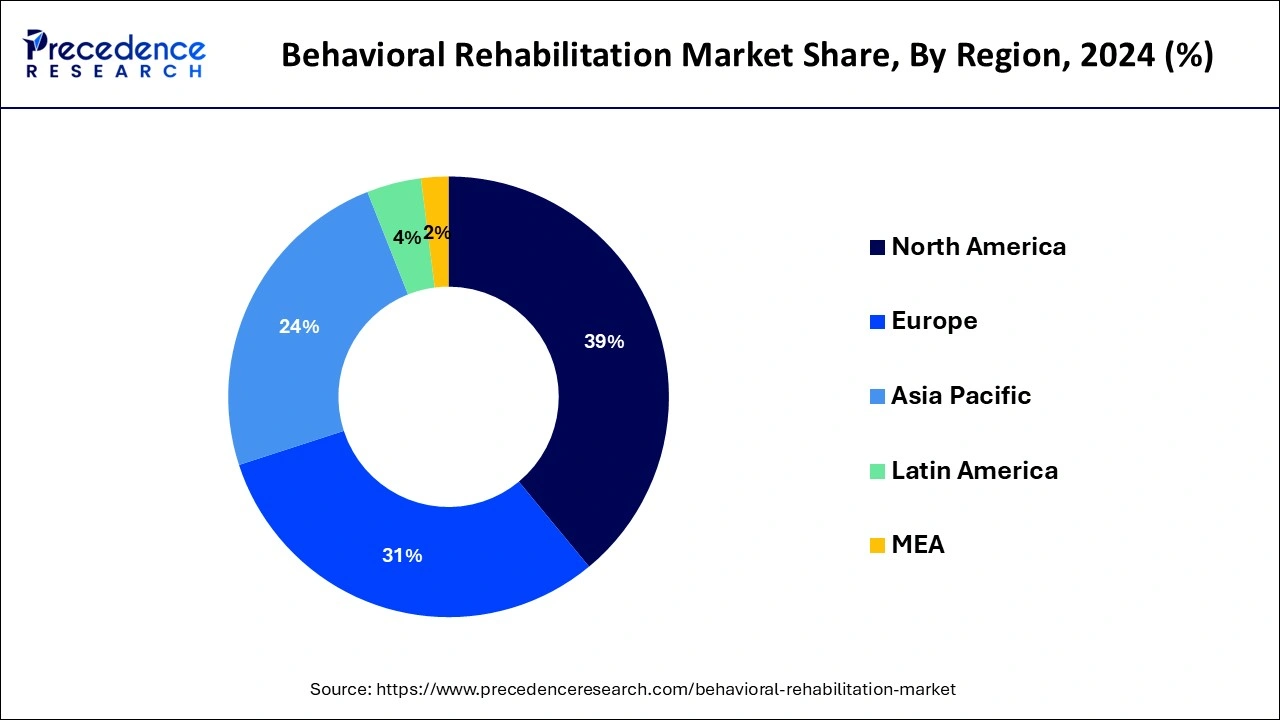List of Contents
What is the Behavioral Rehabilitation Market Size?
The global behavioral rehabilitation market size is accounted at USD 270.35 billion in 2025 and predicted to increase from USD 284.95 billion in 2026 to approximately USD 434.00 billion by 2034, expanding at a CAGR of 5.40% from 2025 to 2034. The behavioral rehabilitation market is driven by the rise in the incidence of behavioral and mental health conditions.

Behavioral Rehabilitation Market Key Takeaways
- North America led the global market with the highest market share of 39% in 2024.
- By disorder type, the anxiety segment has held the largest market share in 2024.
- By application, the outpatient segment captured the biggest revenue share in 2024.
How is AI enhancing the behavioral rehabilitation industry?
Artificial intelligence is significantly improving the behavioral rehabilitation industry via personalized treatment plans, enhanced patient monitoring, and raised accessibility to care. AI-driven virtual assistants offer support, encouragement, as well as reminders to patients, encouraging adherence to treatment plans and enhancing engagement. AI-powered tools can assist optimize treatment plans, contributing to faster recovery times and enhanced functional results. By automating tasks and offering data-driven insights, AI can streamline the rehabilitation process as well as decrease the burden on clinicians.
AI-based neurofeedback systems along with brain-computer interfaces provide new ways to regulate brain activity as well as emotional states, potentially helping in the treatment of numerous mental health conditions.
U.S. Behavioral Rehabilitation Market Size and Growth 2025 to 2034
The U.S. behavioral rehabilitation market size was estimated at USD 74.24 billion in 2025 and is predicted to be worth around USD 121.25 billion by 2034, at a CAGR of 5.60% from 2025 to 2034.

Based on region, North America accounted for over 39% of the market share in 2024 and is expected to sustain its dominance during the forecast period. North America is characterized by the increased prevalence of mental health disorders such as anxiety, depression, and attention deficit disorders. The increased awareness regarding the availability of behavioral rehabilitation services, increased awareness among the population regarding mental health disorders, rising government initiatives to spread awareness regarding the rehabilitation services, and increased consumer expenditure on healthcare. All these are the significant factors that has propelled the growth of the behavioral rehabilitation market in North America in the past few years. Moreover, the recent outbreak of the COVID-19 pandemic resulted in increased unemployment and reduced income, which has increased the prevalence of various mental disorders like anxiety and depressions among the population. Hence, COVID-19 influenced the market growth in 2020, in North America to a great extents.

On the other hand, Asia Pacific is estimated to be the fastest-growing market during the forecast period. This is due to the rising consumer awareness regarding the mental disorders, increasing number of rehabilitation centers, increasing consumer expenditure on healthcare, and rising incidences of drug addiction among the youth. The rise in the consumption of illicit drugs among the young population is expected to boost the growth of the market in the forthcoming years, as consumption of illicit drugs results in various mental health disorders.
Market overview
The behavioral rehabilitation market is undergoing significant expansion due to rising knowledge of mental health and behavioral disorders, combined with increased access to treatment alternatives. Behavioral rehabilitation provides a range of therapies along with programs to address these conditions, which includes individual and group therapy, medication management, as well as specialized programs for addiction and trauma. The growth of telehealth services, mainly in behavioral rehabilitation, is making care more accessible along with affordable by allowing remote access to mental health providers.
Behavioral Rehabilitation Market Growth Factors
The rising prevalence of various mental disorders such as depression, anxiety, and attention deficit disorders are the primary drivers of the global behavioral rehabilitation market. According to the Mental Health Foundation, the most severe cause of increasing medical concerns is the mental health disorders. According to the US Department of Health and Human Services, around 20% of the children and adolescents suffered from mental disorders in their life at some point of time. Around 10% of people suffered from severe emotional disorders at some point in their life. Therefore, the rising cases of mental disorders across the globe is a major factors that propels the growth of the global behavioral rehabilitation market. Moreover, the rising number of service providers, growing expenditure on healthcare, and rising awareness regarding the mental health disorders among the population are several important factors that fosters the market growth across the globe.
The gap between the demand and supply of the behavioral rehabilitation services is huge in majority of the regions and the growth potential is higher for the market participants. Furthermore, the rising incidence of drug addiction among the youngsters is fostering the demand for the behavioral rehabilitation services. According to the United Nations Office on Drugs and Crime,in 2013, around 27 million people were suffering from drug use disorder. Around 24% to 36% of the heroin consuming population passes through correctional system annually in US. Furthermore, the rising prevalence of HIV among the population who injects drug is a significant factor behind the increased demand for the behavioral rehabilitation services. The increasing participation of government and the NGOs in spreading the awareness regarding the mental disorders is expected to fuel the growth of the behavioral rehabilitation market across the globe. The advancements in the field of various therapies like cognitive behavioral therapy is playing a crucial role in the development of the market.
- The global demand for behavioral rehabilitation services has been mainly driven by the rising rates of mental health disorders like depression, anxiety, and substance abuse.
- Rising public understanding of mental health issues and the therapeutic process has fostered the professional rehabilitation programs' acceptance.
- The support of treatment sites is caused by government programs and NGO actions that aim at solving mental health issues.
- Innovations in therapy methods, such as cognitive behavioral therapy and tele-rehabilitation, are making it easier for patients to access these services and are also improving the results.
- The increase in healthcare spending, coupled with the rise in the number of rehab centers, is stimulating the overall market growth in both developed and emerging markets.
Market Scope
| Report Highlights | Details |
| Market Size in 2026 | USD 284.95 Billion |
| Market Size in 2025 | USD 270.35 Billion |
| Market Size by 2034 | USD 434.00 Billion |
| Growth Rate from 2025 to 2034 | CAGR of 5.40% |
| Largest Market | North America |
| Base Year | 2025 |
| Forecast Period | 2025 to 2034 |
| Segments Covered | Disorder Type, Application |
| Regions Covered | North America, Asia Pacific, Europe, Latin America, Middle East and Africa |
Market Dynamics
Drivers
How is growing awareness and acceptance of mental health issues the driving force for the behavioral rehabilitation market?
Growing awareness and acceptance of mental health issues are key drivers for the behavioral rehabilitation market by increasing need for treatment and services. As stigma decreases, more individuals are seeking assistance for mental health conditions, contributing to greater utilization of rehabilitation programs and even driving market expansion. Awareness campaigns and public figures sharing their experiences aid to normalize mental health conditions and decrease the shame linked with seeking treatment. This shift in societal attitudes push more people to access rehabilitation services.
Restraint
How is the limited availability of services a restraint for the behavioral rehabilitation market?
Limited availability of behavioral rehabilitation services acts as a significant restraint on market growth by restricting access to care, mainly in rural and underserved areas. This shortage, stemming from a lack of specialized facilities as well as qualified professionals, hampers the market's ability to meet rising need for mental health services. A shortage of psychiatrists, psychologists, and counselors restricts the capacity of rehabilitation centers to provide comprehensive and effective services. This shortage can contribute to long waiting lists, delayed treatment, and potency lower quality of care.
Opportunity
How are technological advancements an opportunity for the behavioral rehabilitation market?
Technological advancements present significant opportunities for the behavioral rehabilitation market by improving accessibility, personalization, along with effectiveness of treatment. Digital platforms and telehealth solutions permit remote consultations as well as therapy sessions, reaching people in remote areas or those with mobility limitations. Apps and VR platforms can implement gamified elements and interactive experiences to create therapy more engaging and enjoyable, enhancing patient motivation and adherence to treatment.
India Behavioral Rehabilitation Market Trends:
India, which was earlier considered a potential market, is now a rapidly growing one due to the improved awareness and healthcare infrastructure. The government has taken some initiatives, like the digital therapy platform that promotes mental health education and reaches both urban and rural areas. The factors like the increasing working-age stress, drug dependency, and the availability of cheap digital counseling solutions are pushing the Indian behavioral rehabilitation market towards steady growth and modernization, thus contributing more and more to the overall Indian market.
Disorder Type Insights
The anxiety segment accounted for the largest revenue share in 2024 and is estimated to remain its dominance during the forecast period. According to a study, in 2017, around 284 million people were estimated to be suffering from anxiety disorder, globally. According to the Anxiety and Depression Association of America, around 18.1% of the US population aged 18 years or above suffers from anxiety each year. But only around 37% of the patients gets treatment. The availability of antidepressants and advancements in the field of anxiety treatment due to the constant research and development is expected to foster the growth of this segment during the forecast period.
On the other hand, the substance abuse disorders segment is expected to be the fastest-growing segment during the forecast period. This is owing to the rising penetration of illegal businesses and rising unemployment that leads to the addiction of drugs among the people. The drug of abuse is a major cause of the mental disorders and rising awareness regarding this is estimated to fuel the growth of this segment. Furthermore, the inefficiency of the government to curb the illegal business of drug of abuse especially in the developing and underdeveloped nations is expected to boost the number of drug addicts, which in turn will propel the demand for the behavioral rehabilitation services across the globe.
Application Insights
The outpatient segment accounted the largest revenue share in 2024 and is estimated to remain its dominance over the forecast period. This is attributed to the conveniences it provides to the patients. In the outpatient treatment the patient is allowed to return to their homes after attending treatment services regularly. The flexibility associated with the outpatient care makes it favorable for those patients who are at the initial stage of the mental health disorder. This factor makes this the fastest-growing segment too. However, the treatment of substance abuse patient is considered to be ineffective in this type of care. This is so because, the patient, after receiving the treatment can again go back to their home and friends and can consume drugs.
Regional Analysis
How is North America leading in the Behavioral Rehabilitation Market?
The North American region is the largest market, which can be attributed to its well-developed and advanced healthcare system, constantly increasing mental health awareness, and active government support that promotes rehabilitation initiatives. A continually increasing focus on early detection, insurance reimbursement availability, and the blending of telehealth services into patients' healthcare streams adds to the acceleration of growth. Due to the presence of specialized rehabilitation institutions, the availability of qualified personnel, and the ongoing professional development of staff, the region is recognized as the leading one in the behavioral rehabilitation sector regarding both accessibility and quality care that is provided.
United States Behavioral Rehabilitation Market Trends:
The U.S. holds the largest share in the behavioral rehabilitation market, thanks to solid insurance policies and the high use of mental health therapies. Along with these developments, raising public awareness and using technology in the form of telehealth and digital therapies are making things more accessible. The nation's commitment to prevention, the growth of public-private partnerships, and the training of the providers are all contributing to the expansion and innovation of the behavioral rehabilitation sector in the U.S.
What are the driving factors of the Behavioral Rehabilitation Market in Europe?
Europe is an important player in the global market with its powerful healthcare system and good regulations from the government that are in favor of mental health initiatives. The extensive use of digital therapeutics, tele-rehabilitation, and counseling services has made it possible for people in different parts of the continent with different health conditions to have easy access to such services. This health market is gradually growing thanks to society's awareness and the incorporation of rehab in public health policies. Germany and the U.K. are still the front-runners for the innovation of behavioral health service delivery.
Germany Behavioral Rehabilitation Market Trends:
The healthcare system in Germany, the elderly people, and the insurance coverage provided by the government are the factors driving the growth of this market. Digital health, mental health awareness, and the use of therapy technologies have been the main factors of accessibility. The government is increasing the funding in community-based and institutional rehabilitation programs; thus, it is very well positioned and even more so as the leading European country for behavioral health and rehabilitation services.
How is Asia-Pacific performing in the Behavioral Rehabilitation Market?
The Asia-Pacific region is experiencing rapid growth in the behavioral health market, urbanization, and rising stress levels, as well as mental care awareness is a main factor driving this demand. The development of health care reforms, better affordability, and growing acceptance of counseling and therapy services are increasing the demand. Progresses in digital mental health platforms and tele-rehabilitation are making access easier, especially in developing countries, thus making the Asia-Pacific a major region for growth in behavioral rehabilitation services.
Behavioral Rehabilitation Market Companies

- Allergan, Inc.
- Novartis AG
- Taro Pharmaceutical Industries
- Perrigo Company plc
- Zynerba Pharmaceuticals
- Apotex Inc.
- Sandoz AG
- Strides Arcolab Ltd.
- TOLMAR Pharmaceuticals, Inc.
- Limbix
Key Companies Share Insights
The market is moderately fragmented with the presence of several local companies. These market players are striving to gain higher market share by adopting strategies, such as investments, partnerships, and acquisitions & mergers. Companies are also spending on the development of improved products. Moreover, they are also focusing on maintaining competitive pricing.
In May 2020,Limbixreceived around US$ 9 million in series a funding, which will be utilized to develop digital therapeutics for the teens who are suffering from depression.
The various developmental strategies like acquisition, partnerships, mergers, and government policies fosters market growth and offers lucrative growth opportunities to the market players.
Recent Developments
- In August 2025, VHC Health and Lifepoint Health are collaborating to establish a new behavioral health and rehabilitation hospital, enhancing services through Lifepoint's expertise and creating a therapeutic patient environment.
https://www.bizjournals.com - In January 2025, Carisk Partners launches an enhanced Behavioral Health program, integrating Carisk Behavioral Health and HeadsUp Healthcare, to improve access to services and address lower acuity conditions per New York's amended Workers' Compensation law.
https://www.businesswire.com
Value Chain Analysis
- R&D (Research and Development): Conducts extensive behavioral studies to discover new therapeutic and psychological treatment methods.
Key Players: Pfizer, AstraZeneca, Novartis, Merck - Clinical Trials and Regulatory Approvals: Treatments are first evaluated for their effectiveness and safety in multi-phase studies involving humans, and then regulatory approvals are sought.
Key Players: ICON, IQVIA, Labcorp, Parexel, Medpace - Formulation and Final Dosage Preparation: delivery formats to be acceptable are done by incorporating behavioral techniques into patient-specific programs, and so on.
Key Players: Catalent, Lonza, Recipharm - Packaging and Serialization: the process of securely packaging the therapy materials and digital modules, and making them traceable throughout the supply chain.
Key Players: PCI Pharma Services, Almac Group, Catalent - Distribution to Hospitals, Pharmacies: Provides the means for therapeutic tools and resources to reach rehabilitation centers and healthcare institutions.
Key Players: AmerisourceBergen, Cardinal Health, McKesson
Segments Covered in the Report
By Disorder Type
- Mood Disorders
- Anxiety Disorders
- Personality Disorders
- Substance Abuse Disorders
- Attention Deficit Disorders
By Application
- Outpatient
- Inpatient
- Residential
By Region
- North America
- Europe
- Asia-Pacific
- Latin America
- The Middle East and Africa
For inquiries regarding discounts, bulk purchases, or customization requests, please contact us at sales@precedenceresearch.com
Frequently Asked Questions
Ask For Sample
No cookie-cutter, only authentic analysis – take the 1st step to become a Precedence Research client